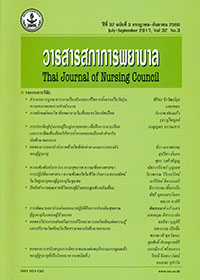ผลของโปรแกรมส่งเสริมการบริโภคอาหารลดโซเดียมต่อความรู้ และปริมาณโซเดียมในปัสสาวะของนักศึกษาพยาบาล
คำสำคัญ:
โปรแกรมส่งเสริมการบริโภคอาหารลดโซเดียม/ ความรู้/ ปริมาณโซเดียมที่บริโภค/ โซเดียมในปัสสาวะ/ นักศึกษาพยาบาล, Program promoting food consumption for sodium reduction/ Knowledge/ Sodium intake/ Urinary sodium/ Nursing studentsบทคัดย่อ
วัตถุประสงค์ เพื่อ 1) ศึกษาความรู้เกี่ยวกับการบริโภคอาหารที่มีโซเดียมและปริมาณโซเดียมในปัสสาวะของนักศึกษาพยาบาล 2) เปรียบเทียบความรู้เกี่ยวกับการบริโภคอาหารที่มีโซเดียมในระยะเริ่มต้นศึกษา ระยะก่อนทดลอง และระยะหลังทดลอง 3) เปรียบเทียบปริมาณโซเดียมในปัสสาวะ ในระยะเริ่มต้นศึกษา ระยะก่อนทดลอง และระยะหลังทดลองและ 4) เปรียบเทียบพฤติกรรมการบริโภคอาหารที่มีโซเดียมของนักศึกษาพยาบาลในระยะเริ่มต้นศึกษา และระยะหลังทดลอง
การออกแบบวิจัย: การวิจัยกึ่งทดลองแบบกลุ่มเดียวควบคุมในตนเอง
การดำเนินการวิจัย: ตัวอย่างเป็นนักศึกษาพยาบาลศาสตรบัณฑิตชั้นปีที่ 2 สถาบันการศึกษาแห่งหนึ่ง จำนวน 44 คน ได้รับโปรแกรมส่งเสริมการบริโภคอาหารลดโซเดียม เป็นระยะเวลา 3 สัปดาห์ เก็บรวบรวมข้อมูลโดยใช้แบบบันทึกข้อมูลส่วนบุคคล แบบสอบถามความรู้เกี่ยวกับการบริโภคอาหารที่มีโซเดียม แบบบันทึกการบริโภคอาหาร และการเก็บปัสสาวะ 12 ชั่วโมง วิเคราะห์ข้อมูลด้วยสถิติบรรยาย การทดสอบทีคู่ การวิเคราะห์ความแปรปรวนแบบทางเดียววัดซ้ำ
ผลการวิจัย: พบว่าตัวอย่างมีค่าเฉลี่ยความรู้เกี่ยวกับการบริโภคอาหารลดโซเดียม 8.6 + 2.2 คะแนนอยู่ในระดับปานกลาง พฤติกรรมการบริโภคอาหารที่มีโซเดียมประเมินจากค่าเฉลี่ยปริมาณโซเดียมที่บริโภค 3,497.4 + 720.2 มิลลิกรัมต่อวัน ซึ่งมากกว่าปริมาณที่แนะนำ และค่าเฉลี่ยปริมาณโซเดียมในปัสสาวะ 2,090.9 + 703.7 มิลลิกรัมต่อวันอยู่ในระดับมาก ในระยะหลังการทดลอง ตัวอย่างมีค่าเฉลี่ยความรู้เกี่ยวกับการบริโภคอาหารลดโซเดียม 13.9 + 0.8 คะแนนซึ่งมากกว่าระยะก่อนทดลอง (10.3 + 2.3) และระยะเริ่มต้นศึกษา (p < .001) ค่าเฉลี่ยปริมาณโซเดียมในปัสสาวะ 1,764.7 + 605.2 มิลลิกรัมต่อวัน ซึ่งน้อยกว่าระยะก่อนทดลอง (2,775.2 + 1087.9 มิลลิกรัมต่อวัน) และระยะเริ่มต้นศึกษา (p < .001) และปริมาณโซเดียมที่บริโภค 2,131.8 +519.5 มิลลิกรัมต่อวัน ซึ่งน้อยกว่าระยะเริ่มต้นศึกษาอย่างมีนัยสำคัญทางสถิติ (p < .001)
ข้อเสนอแนะ: ผลการศึกษาครั้งนี้มีข้อเสนอแนะต่อพยาบาลเวชปฏิบัติชุมชนและทีมสุขภาพสามารถประยุกต์โปรแกรมในการส่งเสริมการบริโภคอาหารลดโซเดียมในนักศึกษาพยาบาล และขยายผลในประชากรกลุ่มอื่น
คำสำคัญ : โปรแกรมส่งเสริมการบริโภคอาหารลดโซเดียม/ ความรู้/ ปริมาณโซเดียมที่บริโภค/ โซเดียมในปัสสาวะ/ นักศึกษาพยาบาล
Downloads
เอกสารอ้างอิง
1. Powles J, Fahimi S, Micha R, Khatibzadeh S, Shi
P, Ezzati M, et al. Global, regional and national sodium
intakes in 1990 and 2010: a systematic analysis of
24 h urinary sodium excretion and dietary surveys
worldwide. British Medical Journal 2013; 3(12):
1136-46.
2. World Health Organization. Sodium intake for adults
and children [online ] 2011. Accessed on December
18, 2015 at. Available from:fle:///F:/9789241
504836_eng.pdf
3. World Hypertension Day 2013 brochure. The World
Hypertension League [online] 2013. Accessed on
December 18, 2015 at Available from: http://
www.worldhypertensionleague.org/Documents/
WHD/2013/WHD%202013%20brochure.pdf
4. Mozaffarian D, Fahimi S, Singh GM, Micha R,
Khatibzadeh S, Engell RE. Global sodium consumption
and death from cardiovascular causes. The New
England Journal of Medicine 2014; 371:624-34
August 14, 2014DOI: 10.1056/NEJMoa1304127.
5. The potential development of Thai people project
and Bureau of Nutrition, Ministry of Public Health.
Synthesis of knowledge frm community mobilization
for nutrition and health care 2016. Bangkok: Golden
point printing. (In Thai)
6. Piaseu N, Tatsanachantatanee D, Kittipoom S, Putwatana
P. Nutritional knowledge, attitude toward food, food
behavior, and nutritional status among nursing students.
Ramathibodi Nursing Journal 2009; 15(1):48-
59. (In Thai)
7. Chapha M. Nutritional knowledge, attitude toward
food, food consumption behavior, and nutritional
status in air force student nurses. Journal of The
Police Nurses 2014; 6(2): 145-57. (In Thai)
8. Carley AG, Karen JC, Lynn JR, Lynn JR, Caryl AN.
Is socioeconomic status associated with dietary sodium
intake in Australian children? A cross-sectional
study. British Medical Journal 2013; 3(2): 1136-46.
9. Xu J, Wang M, Chen Y, Zhen B, Li J, Luan W, Ning
F, et.al. Estimation of salt intake by 24-hour urinary
sodium excretion: a cross-sectional study in Yantai,
China 2014; 14:136. doi: 10.1186/1471-2458-
14-136.
10. He FJ, Yangfeng W, Feng X, Jun M, Yuan M, Haijun
W. School based education programme to reduce salt
intake in children and their families (School-EduSalt):
cluster randomised controlled trial. British Medical
Journal 2015; 350: 770-9. doi: http://dx.doi.
org/10.1136/bmj.h770
11. He FJ, Brinsden HC, MacGregor GA. Salt reduction
in the United Kingdom: a successful experiment in
public health. Journal of Human Hypertension 2014;
28: 345–352. doi:10.1038/jhh.บุญศิริ และคณะ
12. Stevens JP. Applied Multivariate Statistic for the
Social Science (4th ed.) 2002. New Jersey: Lawrence
Eribaum.
13. Choo V. WHO reassesses appropriate body-mass
index for Asian populations. Lancet. 2002 Jul
20;360(9328):235.
14. Ministry of Health. Measurement of waist circumference
[updated 2008]. Available from:http://www. anamai.moph.go.th/ewtadmin/ewt/advisor/main.
php?flename=070304. (In Thai)
15. JNC 8 Guidelines for the Management of Hypertension
in Adults. American Family Physician 2014 Oct 1;
90(7):503-4.
16. Bureau of Non Communicable Disease. Report on
the results of the review.Preventing non-communicable
disease in lifestyle by reducing salt intake 2013.
Bangkok: Printing Workshops.Veterans Affairs under
the Patronage. (In Thai)
17. The potential development of Thai people project
and Bureau of Nutrition, Ministry of Public Health.
Manual for nutrition and health project in community
2016. Bangkok: Golden Point Printing. (In Thai)
18. Piaseu N, Niumngurn S, Sirichakavarn P, Putwatana
P, Panpakdee O. Guide for nutrition label read of
processed food and condiment (4th ed.) 2013.
Bangkok: Golden Point Printing. (In Thai)
19. Piaseu N, Sirichakavarn P, Komindr S. Guide for
nutrition value of dish foods (4th ed.) 2013. Bangkok: Golden Point Printing. (In Thai)
20. Piaseu N, Puttavichaidit B, Sirichakavarn P, Putwatana P. Guide for nutrition label read of snacks
and beverages (4th ed.) 2013. Bangkok: Golden
Point Printing. (In Thai)
21. Thai Health Survey Offce Health Systems Research
Institute. Report of the Food Consumption Survey
of the Thai People Thai Health Survey by Physical
Examination, 2008-2009. Nonthaburi: The Grafco
Systems. (In Thai)
22. Sunthonwaraluk S. The estimation of sodium intake
by semiquantitative food frequency questionnaire
among undergraduate students of Mahidol University.
A thesis submitted in partial fulfllment of the
requirements for the degree of master of science
(public health) major in nutrition, Faculty of
Graduate studies Mahidol University 2008.








